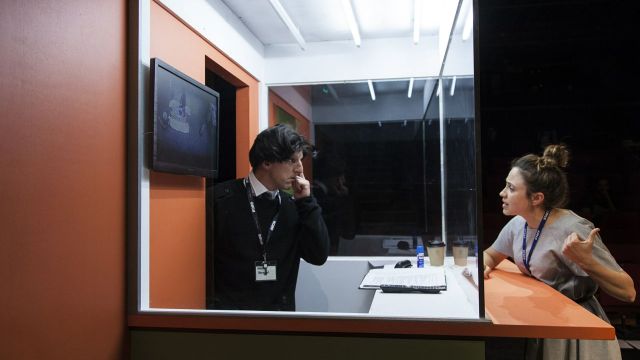A Social Service
Nicola, a ‘conceptual artist’ (or a ‘post-conceptual artist, actually’ as she puts it) is installed as ‘artist in residence’ at a high rise housing estate. She isn’t too sure yet as to what her ‘concept’ is, but that doesn’t inhibit her from being witheringly condescending towards a real resident who already has a substantial project in train. Middle-class Nicola, who may (or may not) have been acclaimed for her ‘Art’ in the cocooned elite art circles she normally inhabits, naturally wants to ‘involve the community’ (on her terms) and she has the armour and endorsement of government funding. It would never occur to her that she is being used, a stalking horse for a scam.
It is difficult – well, impossible – to say more about the story or the cunningly revealed situation in A Social Service without spoiling it for future audiences. Suffice to say it is beautifully structured and concise. It’s way cleverer than your usual agit-prop and it is so because while it is definitely, unmistakeably politically engaged, it dramatises (so economically) a character ‘arc’ or journey for its central character.
 It is also very funny and, as with the most impactful comedy, it’s driven by anger – anger not just at developer scams and government collusion, but also at the insulated middle-class arty types who look the other way. The situation the play depicts is absolutely contemporary. It, or something like it, is happening now in the high rises in North Richmond, in Carlton and elsewhere.
It is also very funny and, as with the most impactful comedy, it’s driven by anger – anger not just at developer scams and government collusion, but also at the insulated middle-class arty types who look the other way. The situation the play depicts is absolutely contemporary. It, or something like it, is happening now in the high rises in North Richmond, in Carlton and elsewhere.
Nicola Gunn, as ‘Nicola’, creates a beautifully modulated character, stripping layer after layer from her initial arrogant confidence down to a still uncomprehending humility. Ms Gunn’s co-creator of the show, David Woods, is equally wonderful in a quite different way. He plays four characters – each one distinct and detailed – the boldest of which is possibly the liaison man for the developers. Rather than a smoothie in a suit or a vulgarian in white shoes, this guy is artistically eccentric, weaving webs of beguiling, soft-spoken reassurance around naïve Nicola – until she is trapped.
In a very bold move, the role of the Community Resident – on stage throughout – is played each performance by a real community resident, the role rotating among Abira De Oliveria, Angelo Duot, Shaan Djuma, Isabelle Mure and Elisabeth Wot. It was Shaan Djuma’s turn on opening night and he maintained a quiet, steady and common sense opposition to Nicola’s solipsistic flummery.
See this show. It is delightful and painful, funny and scarifying.
Michael Brindley
Photographer: Pia Johnson
Subscribe to our E-Newsletter, buy our latest print edition or find a Performing Arts book at Book Nook.

